Aston Villa have been one of the surprise stories of the Premier League season so far, with Dean Smith’s side currently in 9th place in the table. With a couple of games in hand on most teams, the Villans are extremely well placed to challenge for a European spot, sitting just three points off West Ham United in 5th place at the moment. Their resurgence in this campaign, after they escaped relegation on the final day of last season, has been credited to their recruitment in the summer, when a number of high-quality, proven players were brought in to improve every area of Villa’s squad. This has led to a general improvement in Villa’s football, with the attack not solely dependent on captain Jack Grealish anymore, while the defence has also performed much better with the likes of Matty Cash at right-back and Emiliano Martinez in goal helping immensely. Villa have thus made a move to further consolidate their squad in the January window – with Conor Hourihane departing on loan to Swansea City, there was a need to bring in cover for the midfield, and the Clarets have done just that with the signing of Morgan Sanson from Olympique Marseille.
The French midfielder arrives at Villa Park for a fee potentially rising to £15.5m, and has considerable experience in the French top-flight, as well as in Europe, having reached the Europa League final with Marseille in 2018, only to be beaten by Atletico Madrid. This scout report will take a look at Sanson’s profile and characteristics, and how he can fit into Villa’s midfield and tactics.
Playing and statistical profile
Morgan Sanson is a 26-year-old central midfielder, standing 6 ft tall, and is primarily right-footed. He has largely been used as part of a three-man midfield for Marseille this season, as either of the two flanking midfielders, but has also played as an attacking midfielder on occasion. His heatmap for this season so far will help us understand the areas of the pitch where he has been most involved.
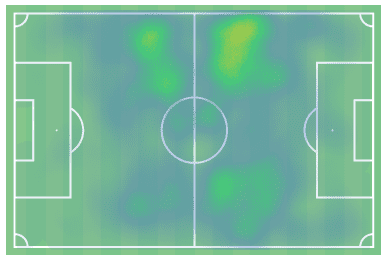
As we can see, the Frenchman has often drifted out to the flanks, both on the left and right, and this sort of movement and positioning could come in handy for Villa as well, to provide support to the likes of Grealish, as well as defensive cover.
Before diving into an analysis of his tendencies on the pitch, it is important to take a look at some statistics to get an idea of where Sanson has been in comparison to other Ligue 1 midfielders. We have only considered central midfielders who have played at least 600 minutes in the league so far this season in order to have an accurate and appropriate comparison. All stats in this piece are taken from Wyscout.
Our first chart looks at creative passing, in the form of passes to the final third and to the penalty area, per 90 minutes.
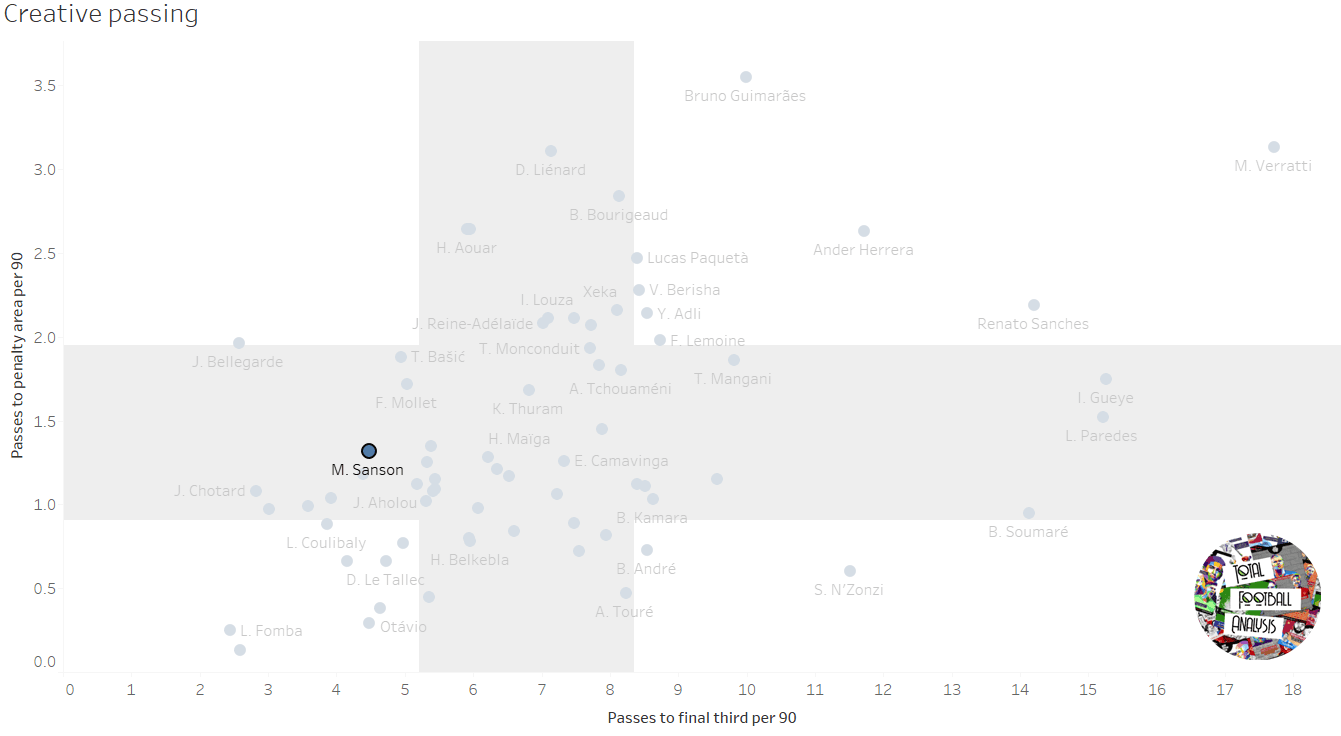
Sanson is highlighted here, and we can see that he does not perform particularly well for either metric. He has made 4.47 passes to the final third per 90 this season, which is well below the median for Ligue 1 central midfielders, while making 1.32 passes to the penalty area 90, which has been around the average for his peer group. This shows that the 26-year-old is certainly not an extremely creative player, and will likely play the role of a facilitator, looking to move the ball quickly to more dangerous players.
This is also borne out when we look at his passing profile, in the form of the number of forward and lateral passes made per 90.
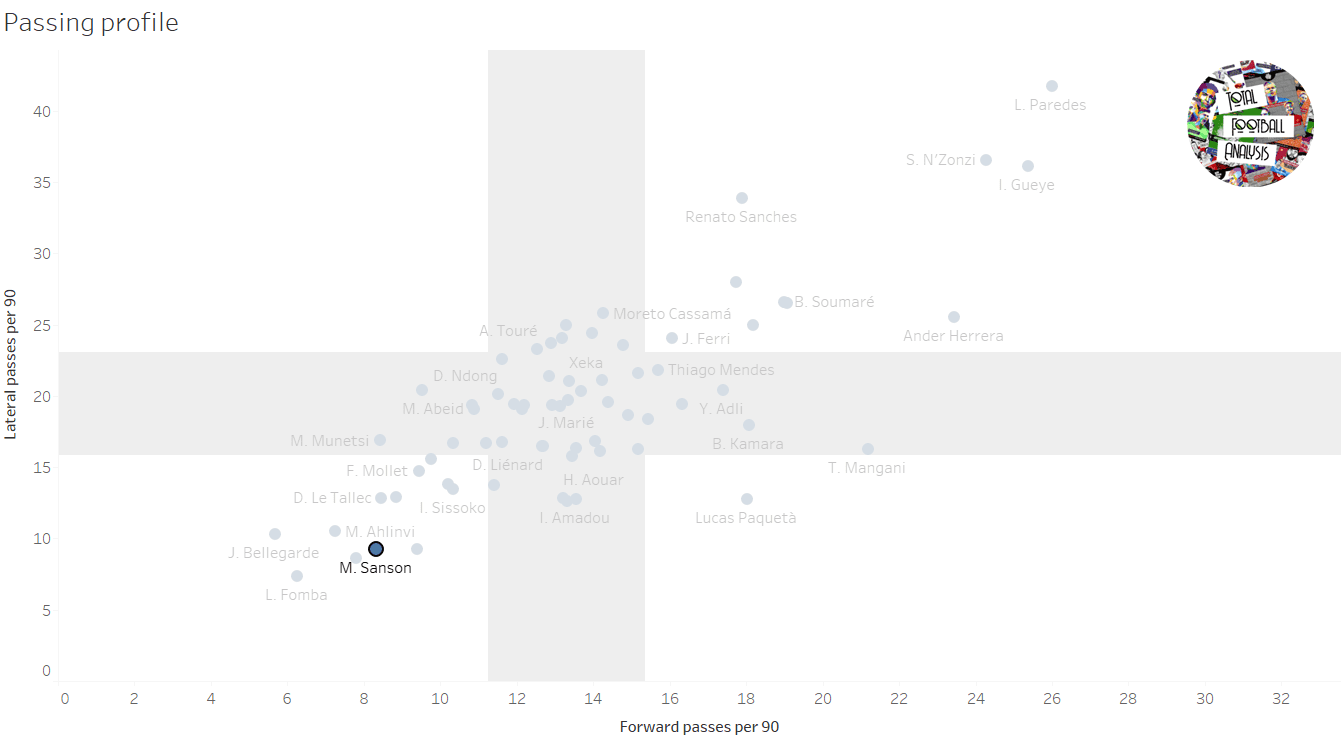
Again, we see that Sanson has not had notable statistics for either statistic, posting numbers well below the median for both metrics. This is also a reflection of the fact that Sanson simply does not make too many passes – he has averaged just over 31 passes per 90 in total, which, is well below the league median of 46.1 passes per 90 for central midfielders, let alone the likes of Marco Verratti, Leandro Paredes and Idrissa Gueye, who lead the league for passes per 90. This actually may lead to him being a good fit for Villa, since the Clarets have been a relatively direct team this season, while Marseille have been more possession-oriented. The fact that he has not had too many passes per 90 despite playing in such a team suggests that he has not been central to their build-up play, and this may suit him at Villa, where he would be largely tasked with recycling possession, and getting the ball quickly to the likes of Grealish, Ross Barkley and Bertrand Traore.
However, Sanson does have a unique way of being a threat from an attacking standpoint – he is a relatively dangerous crosser –
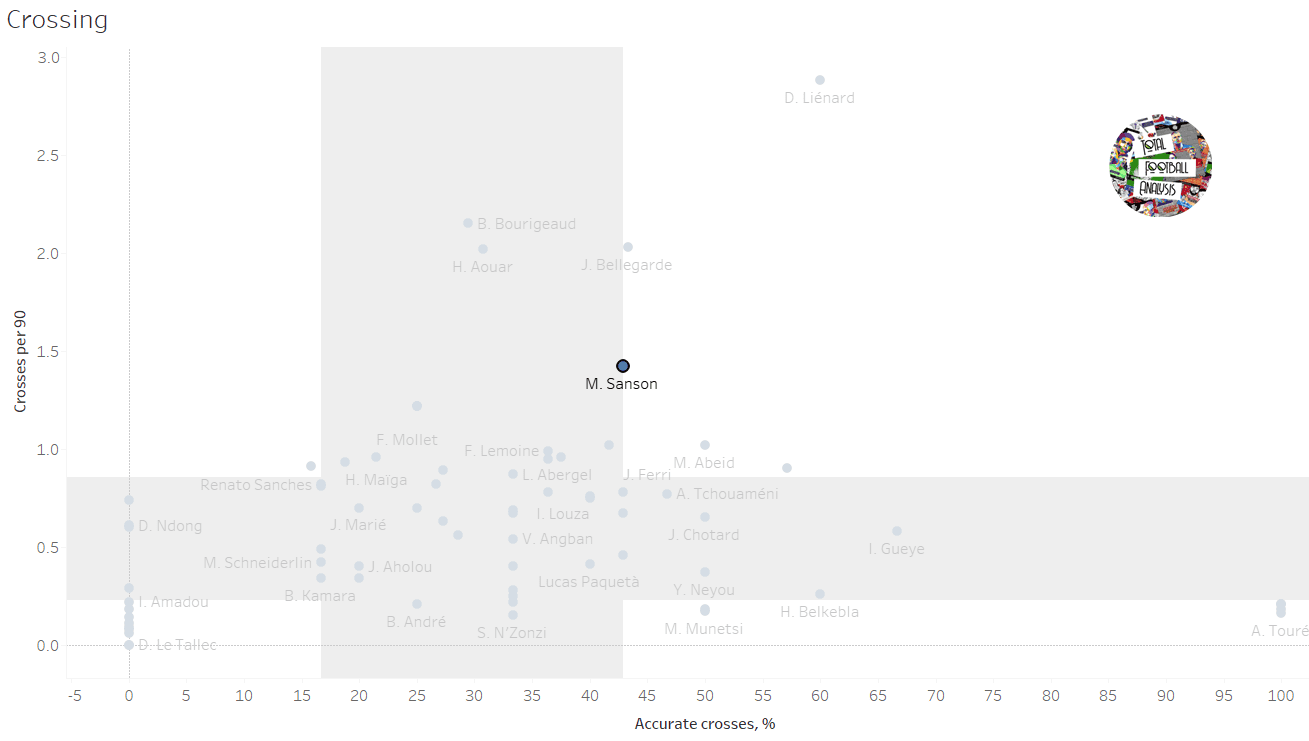
We can see that Sanson has made many more crosses than the league median (1.42/90), while he is also quite accurate with them (42.9%). This, along with his movement into wide areas, which we saw reflected in the heatmap and will see in the analysis itself, adds a unique string to his bow. Sanson can thus add a different route of attack for Villa’s midfield – none of their existing midfielders have a similar trait, other than John McGinn on occasion, and this will allow Villa to build overloads down either flank, or indeed let Sanson advance down the flank himself, freeing Grealish, Barkley and Traore to get into the box.
Another area where he has done well this season is in his goal involvements.
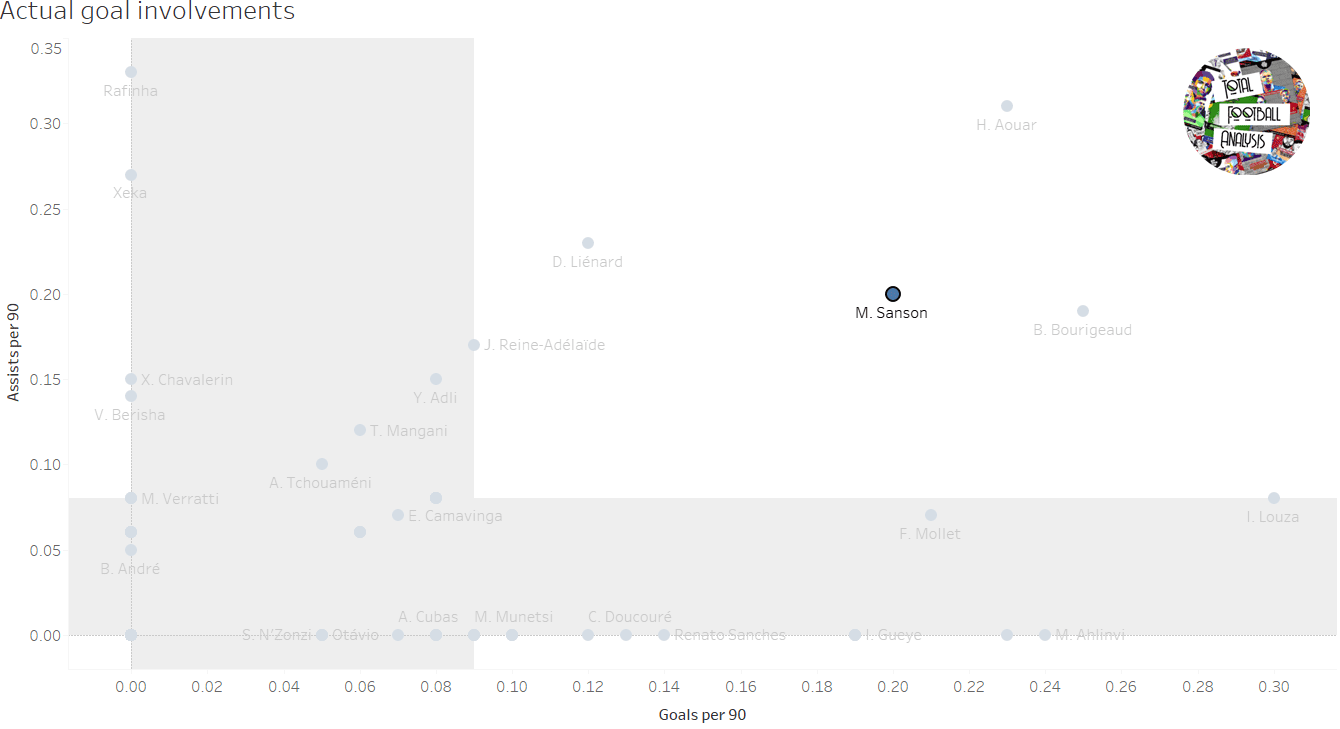
Sanson has two goals and two assists from 886 minutes in the league, giving him one of the highest rates for goals and assists/90 for central midfielders in Ligue 1 this season. This is supported by expected goals and expected assists as well –
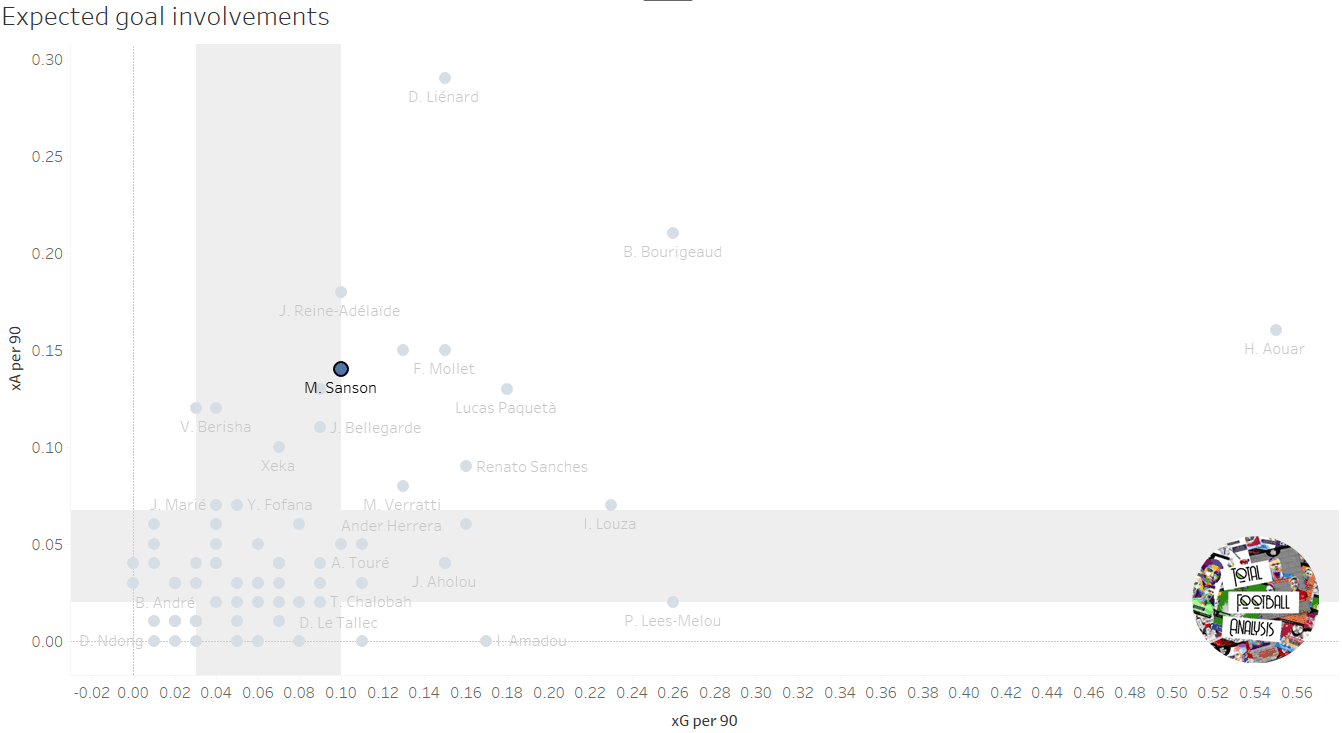
He is outperforming his expected metrics so far this season, but it is still notable that Sanson’s xG per 90 and xA per 90 are both higher than the league medians, showing that he has been a goal threat this season. This is again a promising sign for Villa, who have managed to spread their goalscoring burden a little more since the arrival of Traore, Barkley and Ollie Watkins in the summer, but could do with a little more input from their other midfielders as well.
Thus, these stats show that Sanson is not likely to catch the eye too much at Villa – he will probably slot into one of the places ahead of Douglas Luiz, and be asked to move the ball upfield quickly. However, the Frenchman has shown a knack for goals and assists this season, as well as a penchant for drifting wide and crossing the ball, so it will be interesting to see if he can keep this up at Villa Park as well.
With the statistical comparison out of the way, let us take a look at how Sanson plays on the pitch, and his strengths and weaknesses.
In possession
As mentioned earlier, one of the most unique traits that Sanson has is his tendency to drift wide, either to the left or the right, depending on which side of the midfield he is playing on. The Frenchman does this to link up with the winger and full-back, but often storms ahead himself to deliver crosses, much like a winger would. He is adept at doing so, and he did take set-pieces for Marseille, which means that his delivery from out wide can be a potent, if unorthodox weapon should Villa choose to utilise it.
We can see examples of this positioning and movement here –
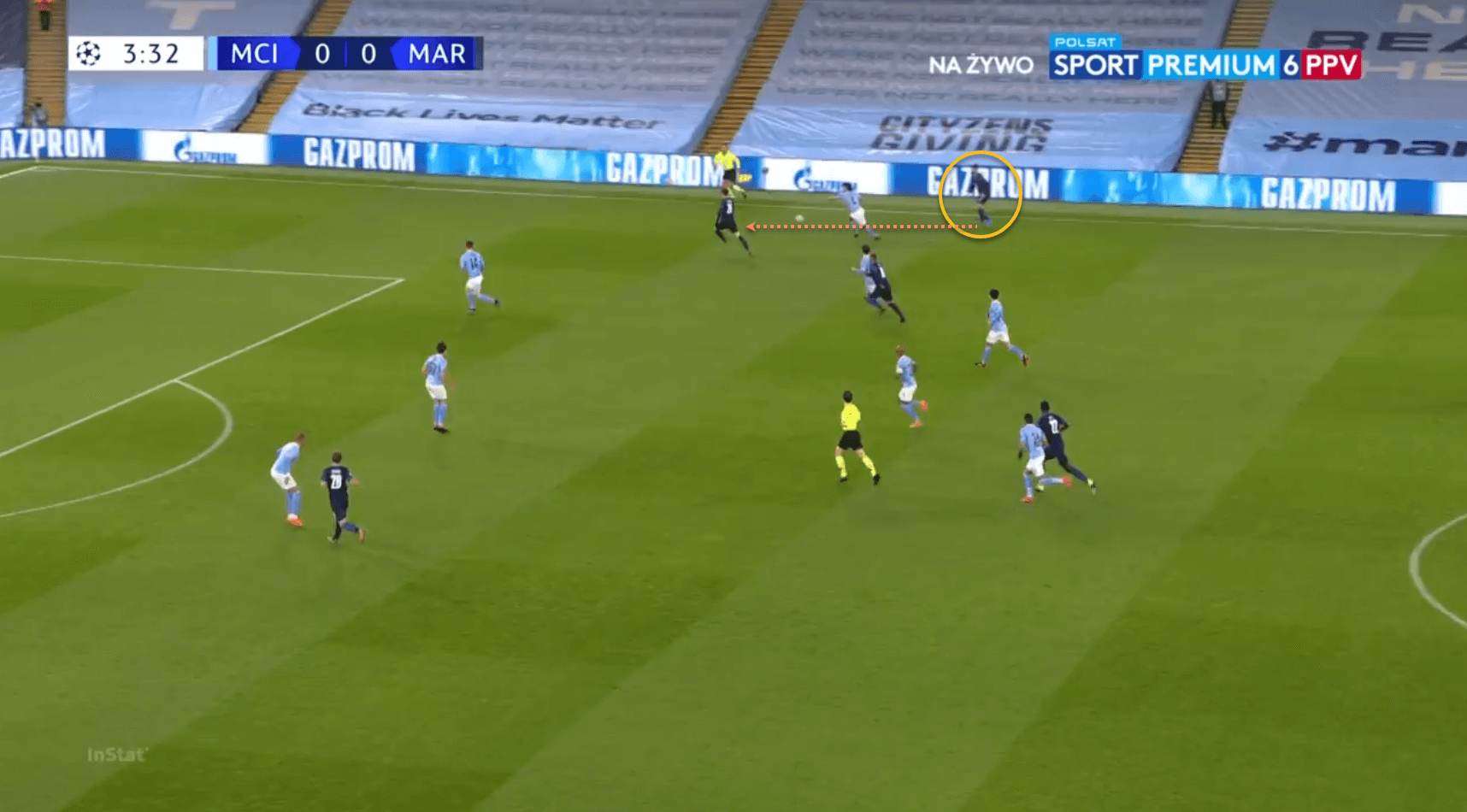
Note how he has pulled wide against City here, and is looking to play the winger in, much like a full-back would.
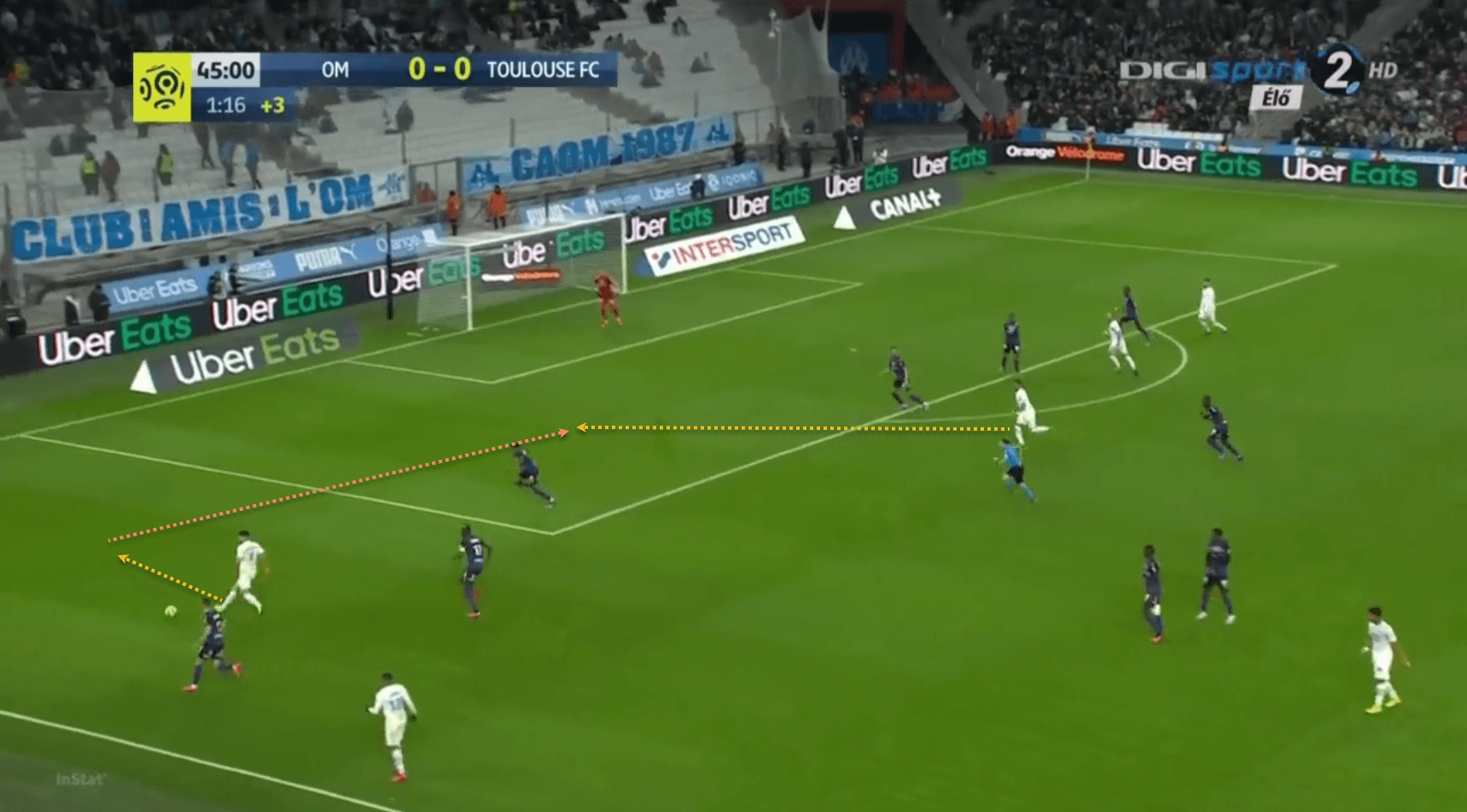
Here, he sprints on to the pass from the full-back, and delivers a low, hard cross for his teammate in an area of the box where there is space.
Sanson’s delivery from wider positions is usually excellent, and he has been able to create chances for Marseille as a result of this.

This was a pinpoint delivery to meet the run of his teammate, which led to a good goalscoring opportunity.
It is also notable that Sanson is extremely comfortable crossing with his supposed weaker left foot, as seen in the examples above. This allows him to drift to the left and go on the outside of the defender, rather than always looking to check inside, and thus adds another weapon to his arsenal when looking to create from wider areas.
When he is not in these areas, Sanson prefers to keep things simple, rarely looking for the killer pass or even an ambitious forward pass, preferring to recycle possession and keep the attack going, rather than risk a turnover.
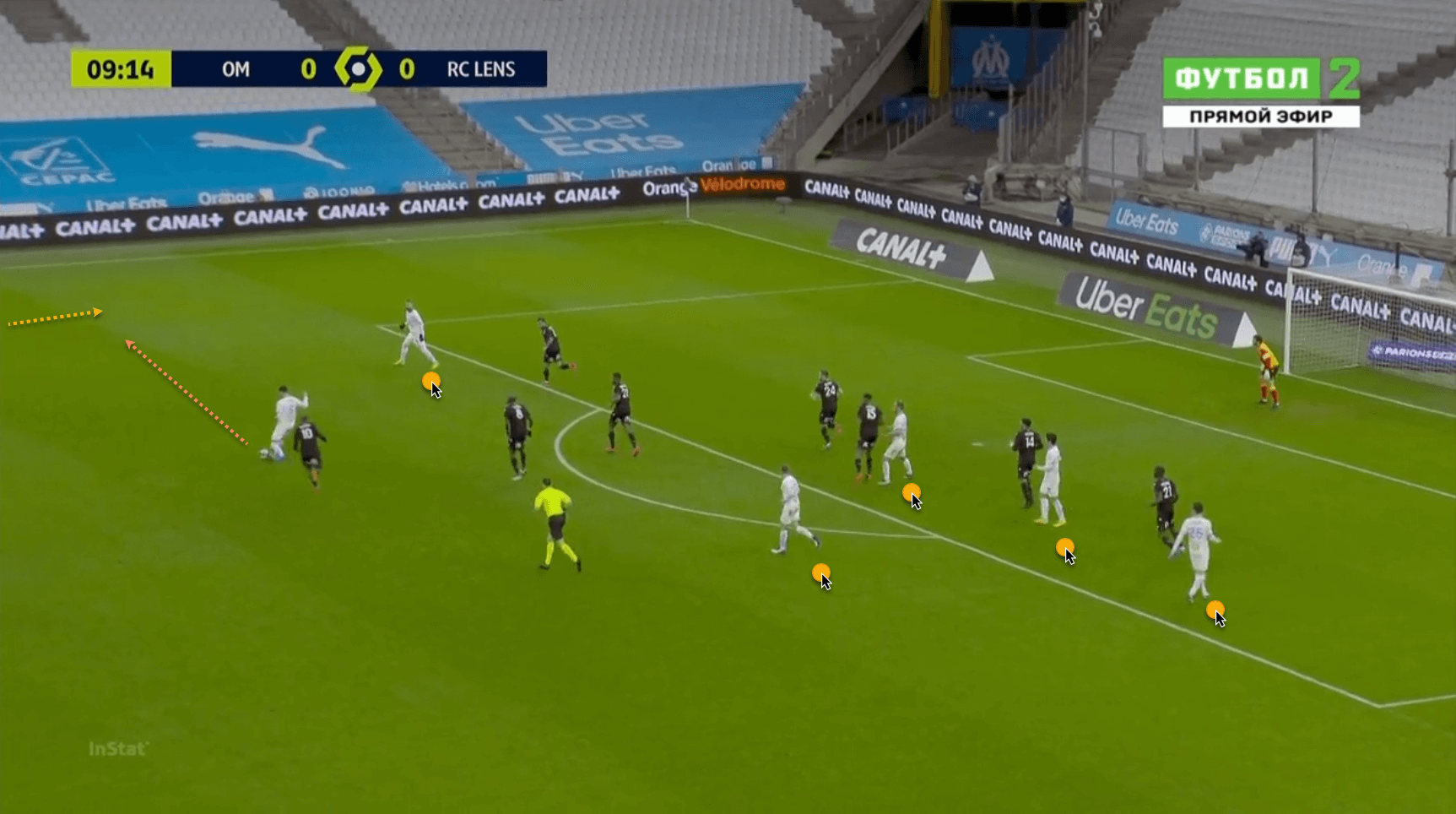
Note that there are five potential Marseille players in and just outside the penalty area for Sanson to try and find, but he opts to pass back to the overlapping full-back instead.
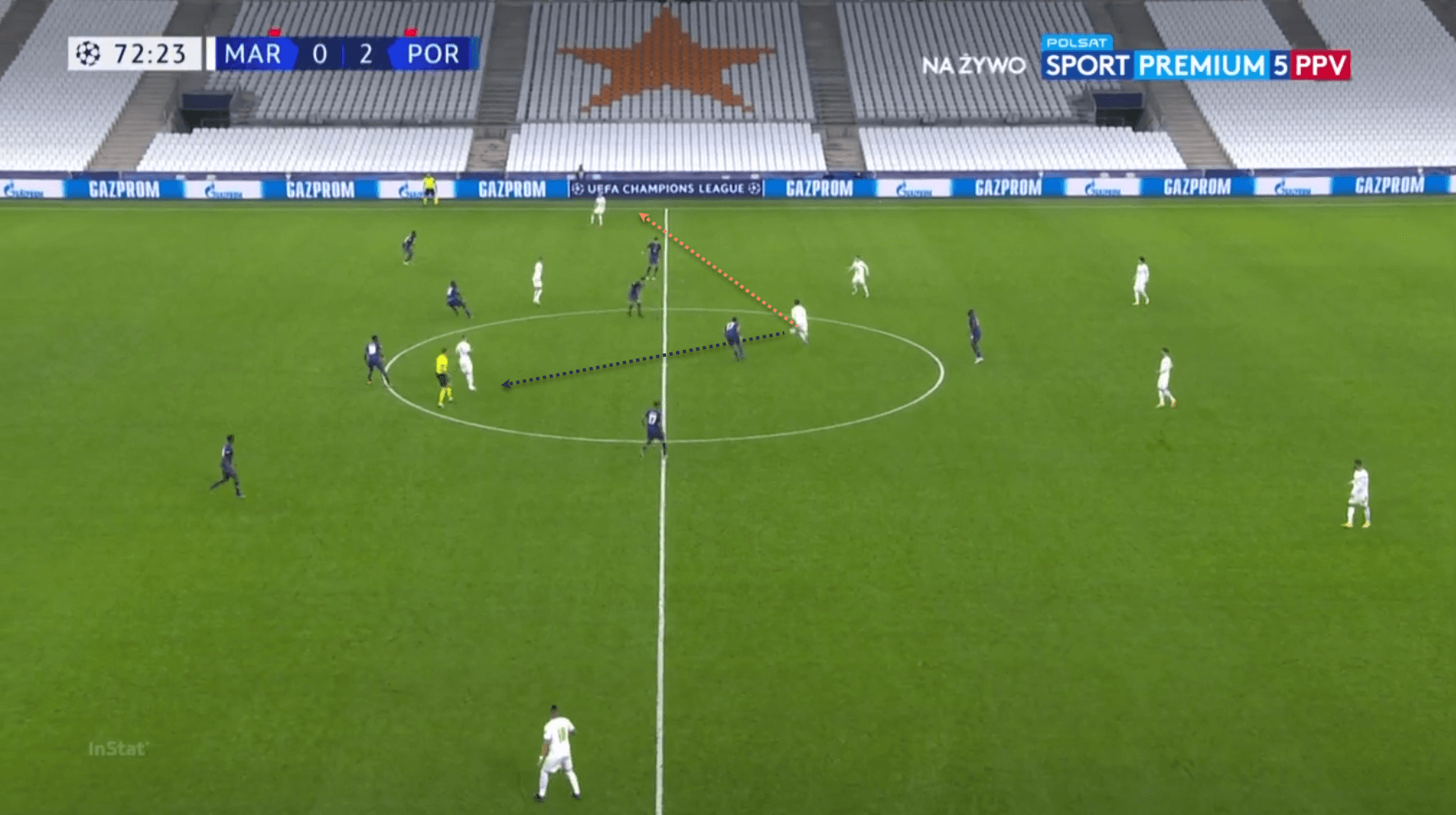
Here, when Sanson picks the ball up, there is a potential pass to the centre-forward available. It is not an easy pass, but could immediately set Marseille on the attack if executed perfectly. Instead, he chooses to move the ball wide with a simpler pass out to the full-back, which retains possession and allows his team to build-up in a more patient manner.
This ability or trait of his to try and retain possession could come in handy for Villa, given that they are a relatively direct and vertical team, and therefore do tend to lose possession of the ball at times. Villa have averaged the sixth-lowest passes per 90 of any team in the Premier League this season, and so a player who can offer a little bit of composure at times could be a welcome addition.
That is not to say that Sanson cannot pick a pass when needed. He has the ability to play defence splitting passes when the opportunity presents itself –
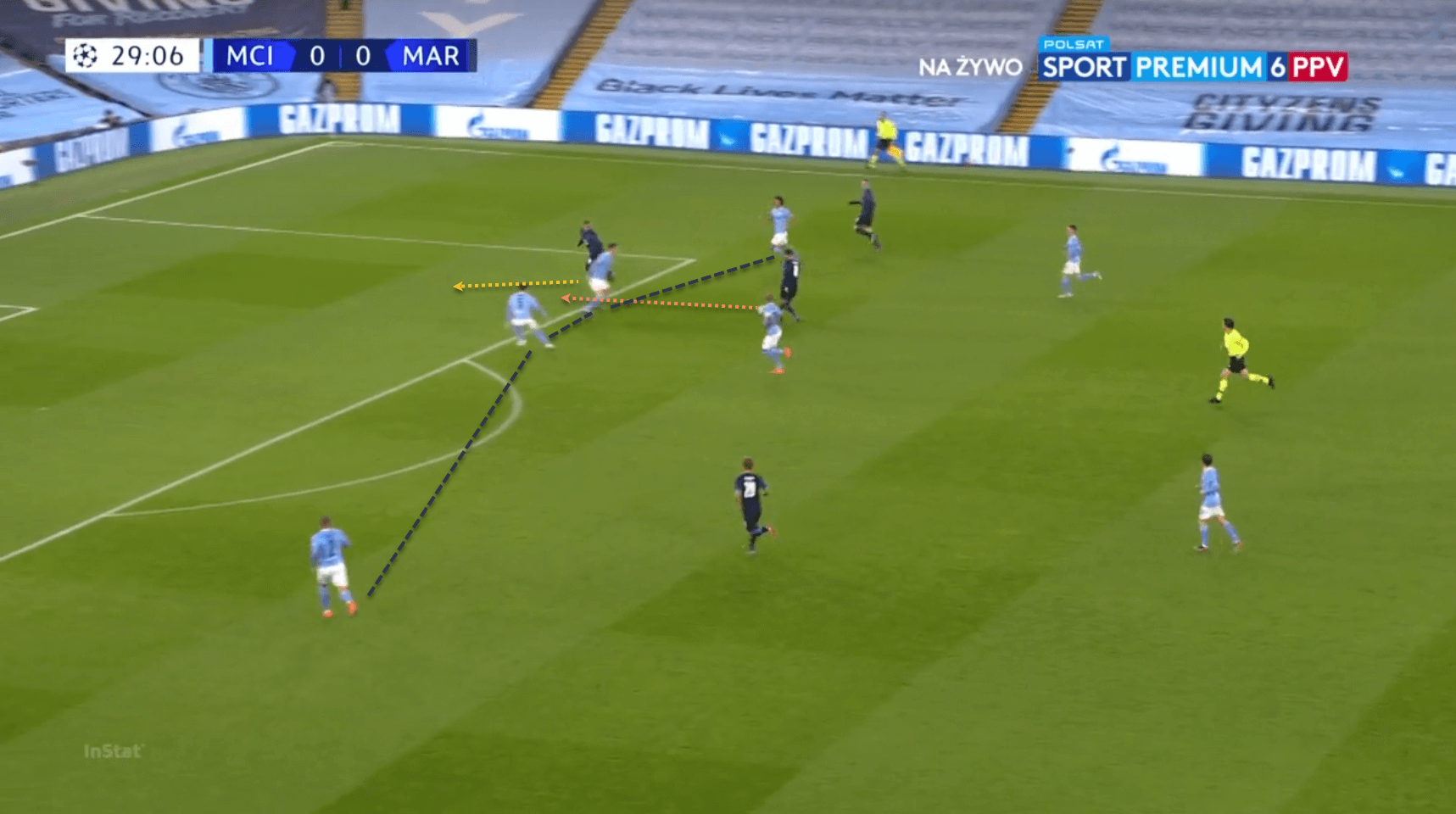
The 26-year-old plays his teammate through on goal to finish, although it was called back for offside.
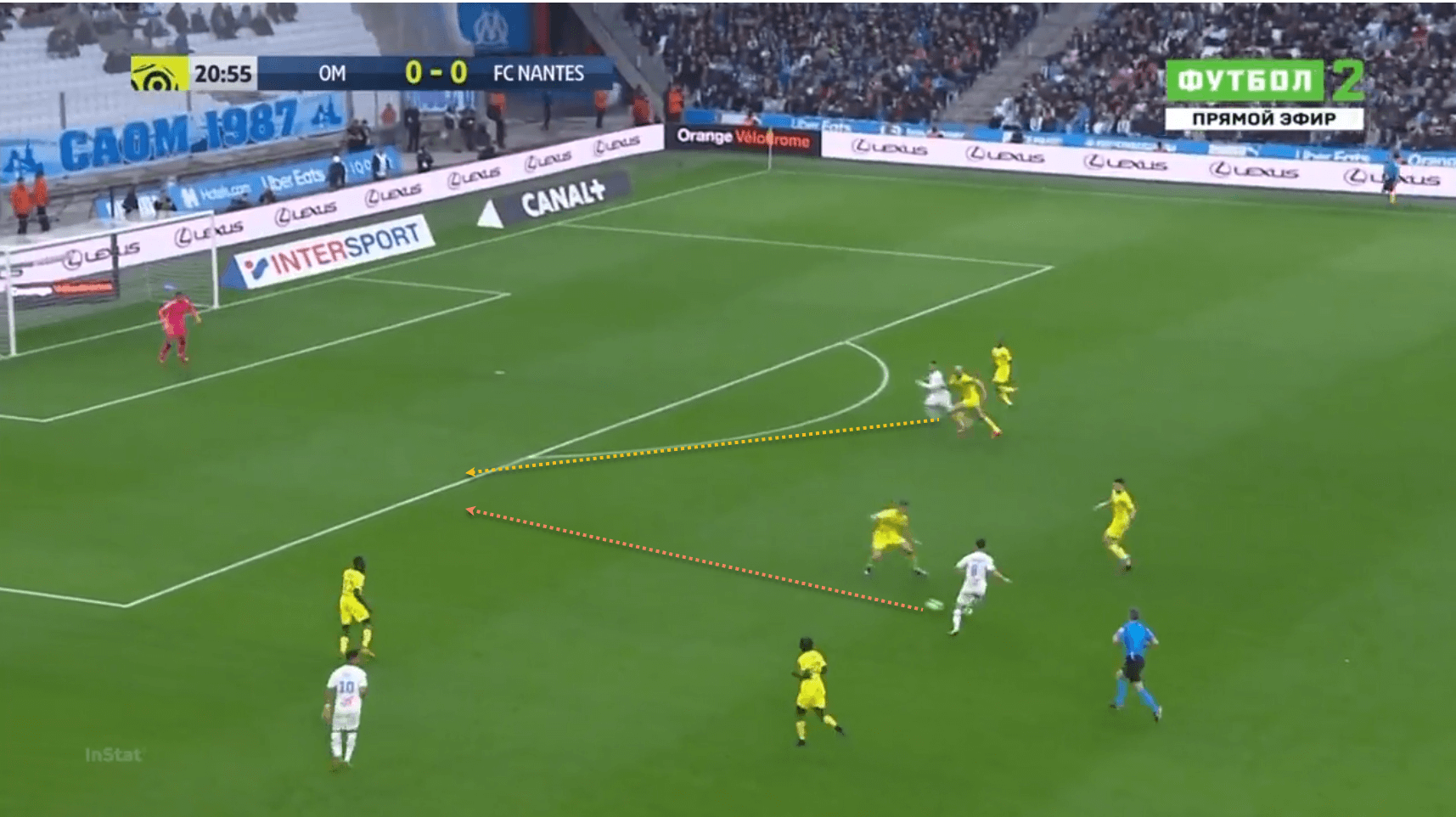
Here, he plays the ball into a dangerous area for the striker to run onto and win a penalty for Marseille.
Another important trait which will be helpful for Villa is his ability to play long passes into space when counter-attacking. This is something that could be of huge value to the Clarets, given that they are not a possession-heavy side, and setting the likes of Watkins, Traore and Grealish free with passes into space will be extremely valuable.
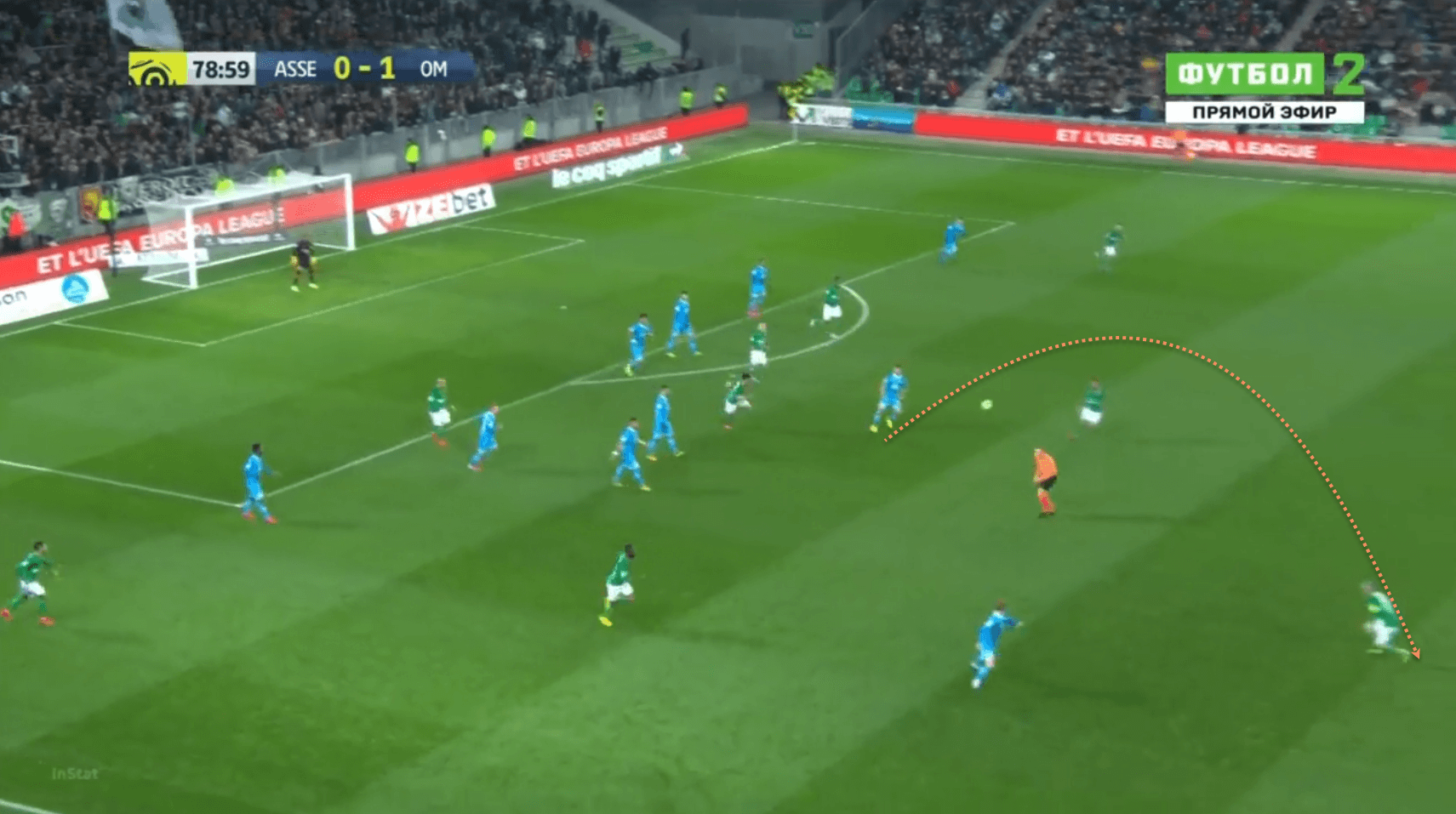
In this situation, Sanson receives the ball and immediately plays a first-time pass for his winger to chase. Note just how deep Marseille are, and therefore how much space there is if the winger can get onto the ball…
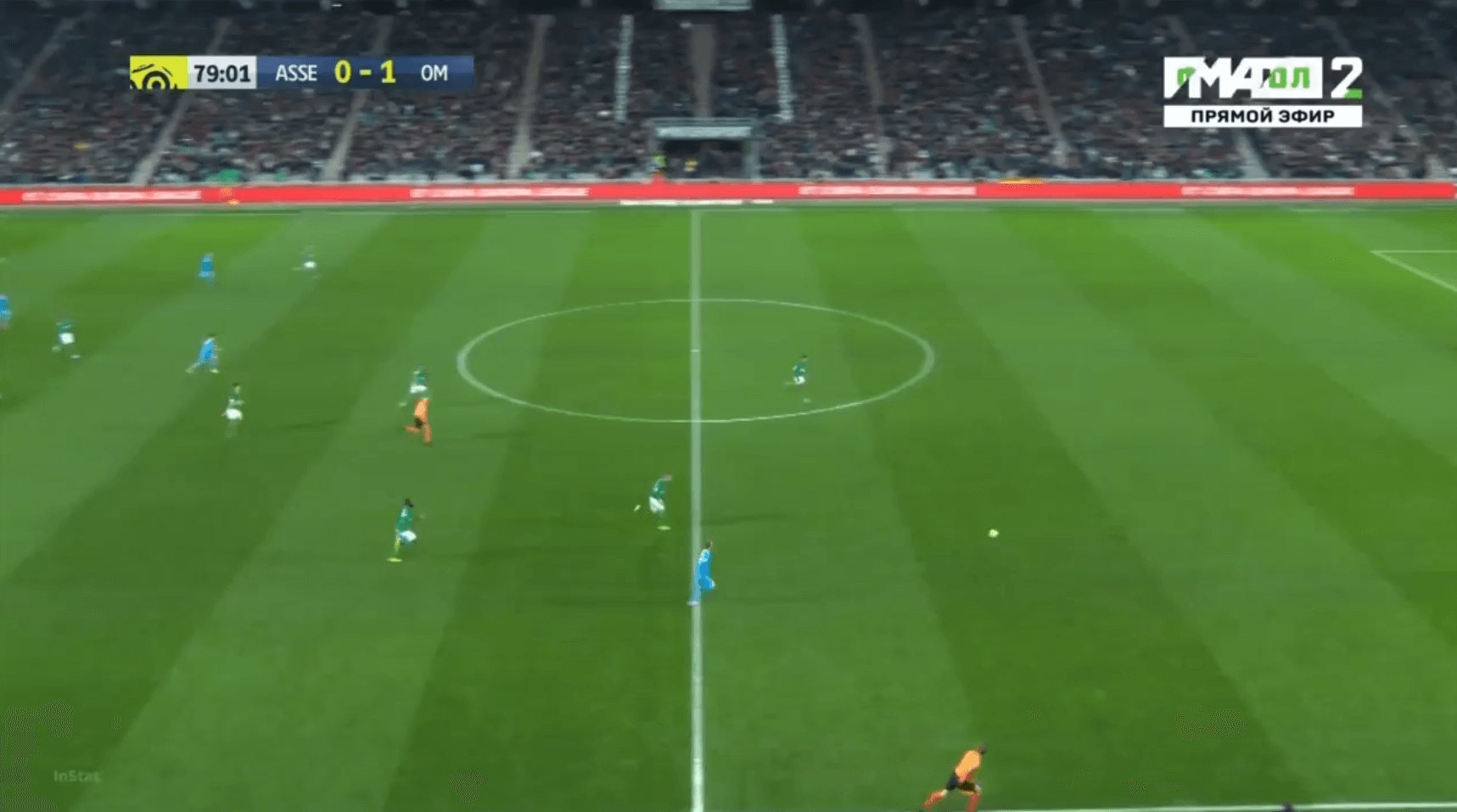
…which, as we see, he can.
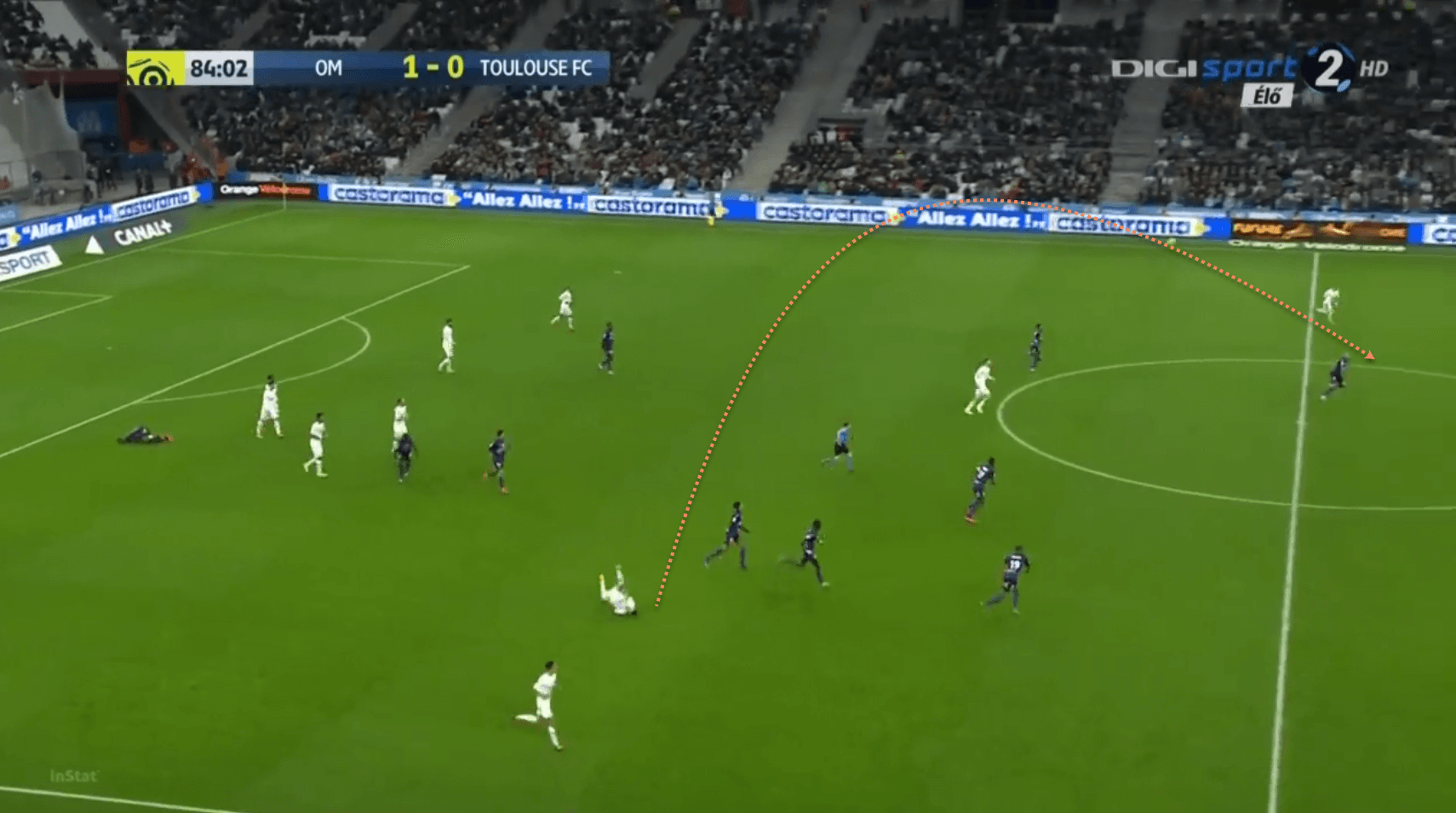
Another example of this here, where Marseille are able to counter-attack quickly because of an accurate long pass played into space, even though he has fallen over while playing the pass.
Sanson is usually only in position to play these passes during the offensive transition, when Marseille have just regained possession. When they have extended spells on the ball, he is usually higher up the pitch or out wide. Thus, his trait of playing these passes from deeper positions in transition can be a big weapon for Villa to be able to attack into space.
In possession, Sanson will offer a threat from out wide, while electing to keep it simple in central areas, and facilitating the likes of Barkley and Grealish, rather than trying to make the killer pass himself.
Out of possession
Dean Smith’s Villa side have been one of the surprises of the season, in that they are one of only three sides who are pressing more intensely than they were last season, when measured through the passes per defensive action (PPDA) metric. Villa’s PPDA of 11.43 at the time of writing is the fifth-lowest in the league, making them one of the more aggressive pressing sides, and this is tied to another metric as well, challenge intensity. Wyscout’s challenge intensity metric measures how many defensive actions (defensive duels, interceptions, loose ball duels and tackles) a team is making per minute of the opponent’s ball possession. Villa are again in fifth place for this metric as well, with a rate of 6.30 actions per minute. Thus, we can see that the Clarets are a fairly active team when out of possession, but Sanson should have no problem adapting to this. Marseille are one of the highest pressers in Ligue 1 – their PPDA of 10.45 is the second-highest in the league, while their challenge intensity number of 6.50 is the highest along with PSG. Thus, Sanson should not have too much difficulty adapting to the defensive work-rate that will be asked of him at Villa Park.
We can take a look at Sanson’s defensive numbers, in comparison to his Ligue 1 peers, in the chart below –
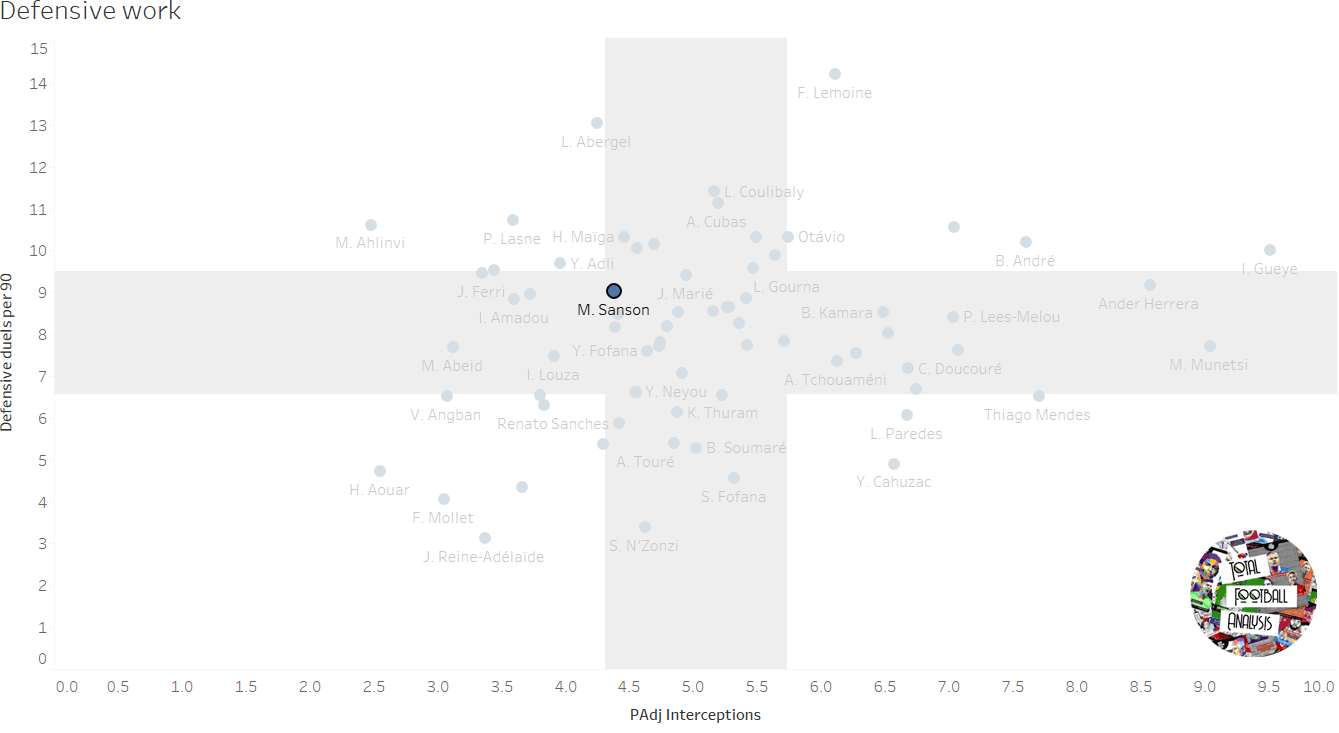
It is encouraging that he has been around the league medians for both defensive duels per 90 and PAdj interceptions (possession-adjusted interceptions). This shows that he should be able to find his feet in terms of the work-rate required defensively at Villa, and thus bodes well for Dean Smith.
Sanson often led the press for Marseille, especially when played as an attacking midfielder, but would also be asked to hold the midfield line and not advance too far in order to stay in a compact shape. He can expect more of the same at Villa Park, and this should be a relatively seamless introduction, at least in theory.
Weaknesses
Sanson can get caught out of position during defensive transitions if he has drifted out wide, so it will need intelligence from the full-back as well as Douglas Luiz to ensure that Villa are not caught out in such situations. He is also not the best in the air, despite being 6 ft tall – he has only won 32% of his aerial duels this season, which is well below the league median.
Conclusion
Villa have managed to make a solid addition to their squad in the form of this 26-year-old midfielder. He has enought top-level experience to not be fazed by the challenge of playing in the Premier League, while he also adds a couple of unique traits and attributes to the Villa midfield. It will be fascinating to see his progress at Villa Park, and we expect that he will be a solid squad option for the Clarets, with the potential to play consistently in one of the two midfield roles ahead of Douglas Luiz.





Comments